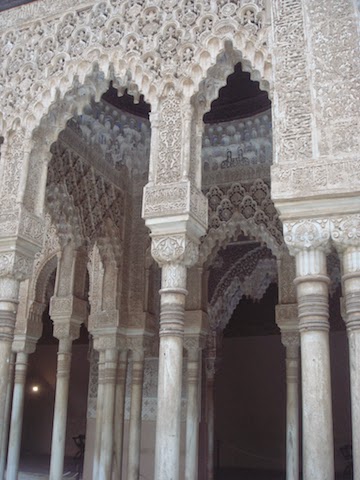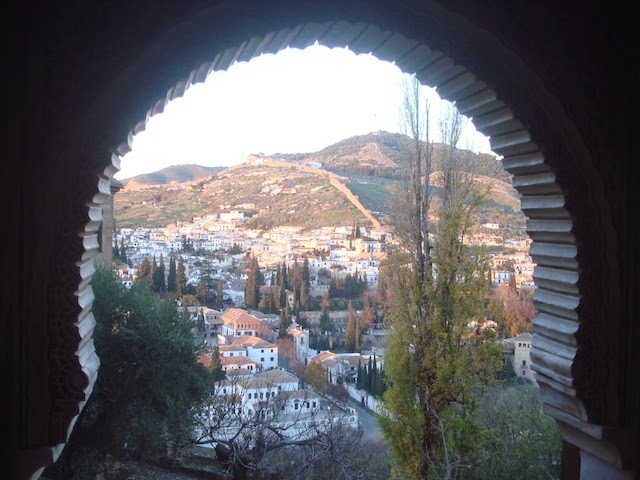This past weekend was a long weekend or as they call it in Spain,
un puente (literally, "a bridge"). Monday, the 8th, was a holiday - the Feast of the Immaculate Conception or
la Inmaculada - and it was an extra special puente for the Spaniards since Saturday, the 6th, was a holiday as well -
Día de la Constitución Española (Constitution Day) or
la Constitución for short. As the name suggests, it's the day when Spain approved its new constitution marking the country's transition to a constitutional monarchy and democracy. Since the two holidays are celebrated each year, this special long weekend even has a name:
Puente de la Inmaculada. If the 6th falls on a Monday and the 8th on a Wednesday (or a Wednesday and Friday respectively), they get a 5 day weekend. I'm not sure what happens though if the 6th falls on a Tuesday and the 8th on a Thursday! It's a pretty festive weekend; a lot of families go out of town (Granada in particular was packed with visitors) and a lot of stores hold a special weekend sale.
While the Spaniards had their 3-day weekend, we
auxiliares had a 4-day weekend since we don't work on Fridays. Instead of taking a trip out of town, Lyle and I stayed in Granada and our fellow UP coursemates and
auxiliares Zed and Julie came down to visit.
 |
| From UP to Granada! |
No trip to Granada is complete without a visit to the
Alhambra, so of course we set out to do that. I really had planned to buy tickets in advance, but I forgot it was a
puente so it sold out quicker than usual. Tickets for the 6th 'til the 8th were already sold out when I checked two weeks before the date, but luckily there were still some available for the afternoon of the 5th. So on Friday afternoon, as soon as Zed and Julie arrived from Madrid, we headed straight to the Alhambra.
 |
| In front of the "Puerta de las Granadas" which leads up to the Alhambra |
From
Plaza Nueva we walked past the
Puerta de las Granadas (Gate of the Pomegranates) up
Cuesta de Gomérez which leads to the Alhambra. After about 15 minutes or so of walking we reached the
Puerta de la Justicia (Gate of Justice) and entered the Alhambra. It was then that I realized that you can actually enter the Alhambra complex without a ticket by passing this gate. You
do need a ticket (€15,40) to see the Alcazaba, the Nasrid Palaces and the Generalife, but if you just want to stroll around the grounds and bask in the view, you can just walk in. You can even visit the Charles V Palace and the free museums and exhibits inside it.
 |
| "Puerta de la Justicia" |
La Alhambra is Granada's crown monument, and Spain's most visited tourist attraction. Alhambra, which means "red castle or red fort" in Arabic, is a Moorish fortress and the only surviving large medieval Islamic palace complex in the world. Now a UNESCO World Heritage Site, it was built during the Nasrid dynasty, which held Granada as its capital. It was strategically located on a high plateau, and now also offers great views of the city.
There are four main sites to visit in the Alhambra:
el Alcazaba, los Palacios Nazaríes (Nasrid Palaces)
, el Palacio Carlos V (Charles V Palace)
, and
el Generalife. You can only visit each monument once and the Nasrid Palaces at a specific time printed on your ticket (ours was at 5pm).
We headed to the
Generalife first since it was on the far end, away from the other three, and since we had to be back at the main area before 5pm to visit the Nasrid Palaces. The
Generalife was a summer palace, built in the 13th century as a place for the rulers to get away from it all. As it is a bit away from the main complex, it was a perfect place for rest and relaxation.
 |
| Pathway leading to the Generalife gardens |
 |
| Generalife and the gardens |
Water plays a major role in the Generalife, and the palce is abundant with water gardens and fountains.
 |
| Patio de la Acequia |
Even though it's technically winter already, there were still some beautiful fall colors in the gardens. We were also blessed with good weather that day; blue skies and the sun was out, so thankfully it wasn't that cold.
After strolling through the Generalife and the gardens, we headed back to the main complex and visited the Palacio Carlos V. El
Palacio Carlos V was not originally part of the Alhambra; it was added by the Christian King Carlos V.
 |
| Facade of the Palacio Carlos V |
Built in the 16th century it's of Renaissance and European design. What's most intersting about t is that it has a square exterior with a circular courtyard on the inside.
There are two museums inside: the
Museo de la Alhambra and the
Museo de Bellas Artes (the first is free and the second has a small fee). The Museo de la Alhambra was closed though when we vsited, and we opted not to see the Museo de Bellas Artes. We went instead to the special exhibit on the second floor on Flamenco singer Enrique Morente when we visited.
We didn't have much time left as it was almost 5pm so we skipped the Alcazaba and waited in line to enter the Palacios Nazaríes. We took some photos with the Albayzín as our backdrop while waiting.
The
Palacios Nazaríes are the heart of the Alhambra (and where most of the picture perfects spots are). A complex of three interconnecting palaces, these palaces were built in the 14th century by the Nasrid kings, and each have such interesting stories to tell. (I downloaded a free audioguide app which was crudely translated into English which made for some funnily translated stories). The three palaces are the
Mexuar, Palacio de Comares, Palacio de los Leones. Each had different functions - the Mexuar was used for administration and state affairs, the Comares Palace was the official resident of the king, and the Palace of the Lions was the residence of the royal family. There are many many rooms in the palaces from bedrooms to council rooms to courtyards, but for me the most interesting part is the beautiful and intricate decorations.
 |
| Facade of the Comares Palace |
Everywhere you go you are surrounded by such designs, and it seems that every wall, arch, pillar, and even the ceilings are such beautifully decorated. The details are amazing -- from glazed tiles to lines in Arabic script to geometrical patterns... it's easy to just stand and stare and marvel at all the intricacy.
 |
| Patio de Arrayanes |
 |
| Ceiling in the Sala de los Abencerrajes |
 |
| An arch in the throne room |
 |
| Love these two! |
Finally, we reached the famous
Patio de los Leones. The last time I visited this patio was sadly closed as it was under restoration, so I was really excited to finally see it. The courtyard is decorated with 124 white marble columns, and in the center is a fountain supported by twelve lions. Water flows from the jaws of the lions and the twelve lions supposedly symbolize the twelve signs of the zodiac and eternity.
The Alhambra is a truly magical place and well worth a visit. After visiting all the rooms in the Nasrid Palaces we walked around the grounds a bit more before heading back down. (In the winter, the Alhambra closes at 6pm instead of 8). We were back down in Plaza Nueva before 7, and we stopped by our favorite
tetería for some tea.
Teterías are abundant in the Albayzín area (which was the Moorish neighborhood) along with Moroccan restaurants.
For dinner we went out for tapas with one of Lyle's colleague and his friends. All in all a great way to start the
puente.







































Comments